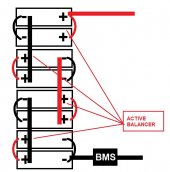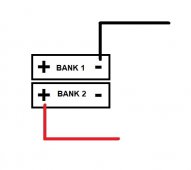Steve Dally
New Member
- Joined
- May 10, 2021
- Messages
- 16
So, I'm not sure what's going on here... I built up 2 separate batteries, each one with brand new 3.2v 280 amp hour lifepo4 prismatic cells, 4s configuration, using an overkill BMS on each. Then the two batteries are in parallel to the positive and negative bus.
Everything seems great except this: they aren't discharging equally during low draw loads. A 5 amp load, for example is pulling 4.5 Amps from one battery and a half amp from the other. Larger draws (100 amps for example) pull equally from the batteries.
The weird thing is that this wasn't happening the the first 3 weeks after I installed them, it just started a few days ago, when I noticed that one battery was down to 80% and the other was still at 99%.
Am I right to be concerned by this? Any ideas of what might be causing it?
Here's a little background info, just in case it's helpful:
I top balanced all of my cells prior to building the batteries. Both batteries were charged to 100% (I'm calling 3.5v for cells and 14.0v for pack a 100% charge)
Everything seems great except this: they aren't discharging equally during low draw loads. A 5 amp load, for example is pulling 4.5 Amps from one battery and a half amp from the other. Larger draws (100 amps for example) pull equally from the batteries.
The weird thing is that this wasn't happening the the first 3 weeks after I installed them, it just started a few days ago, when I noticed that one battery was down to 80% and the other was still at 99%.
Am I right to be concerned by this? Any ideas of what might be causing it?
Here's a little background info, just in case it's helpful:
I top balanced all of my cells prior to building the batteries. Both batteries were charged to 100% (I'm calling 3.5v for cells and 14.0v for pack a 100% charge)






